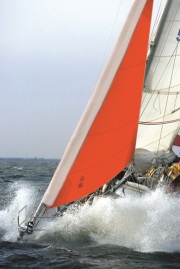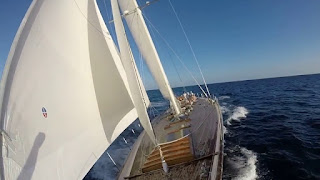Storm sails
USING YOU STORM SAILS
Whether we like it or not, on occasions the
sport of yachting can be dangerous, anyone who has ventured into or been caught
in extreme conditions can vouch for this. We always talk in yachting circles of
the value of practice and preparation, yet one area that we tend to ignore is
the art of survival in extreme conditions.
Several years ago it became quite common
for a lot of ocean race organizing committees to insist that prior to the start
of the race the competitors sailed through a set of buoys with their storm
sails set and drawing. This is a great initiative as I am sure that on a lot of
race boats this would be the only time that these sails are brought out of the
bag. Even so; I am always amazed at the bungled and botched attempts that ensue
when the setting up of the storm sails is done on these occasions. I have even
been on a boat where the trysail has been set upside down in broad daylight and
light winds, imagine the confusion if that happened in the middle of the night
in a howling gale.
Storm
sails
The various yachting authorities have
several uniform decrees that cover storm sails, they must be made of orange
cloth for superior visibility, they must not be over a certain size and be
built in a suitably robust manner, storm jibs designed to go on headfoil must
have an alternative method of connection to the forestay and all storm sails
must have their sheets permanently connected.
Storm sails have a completely different set
of criteria from other sails when being made; they are to be used in the most
violent of conditions and must be constructed accordingly. Over sized corner
patches, multiple rows of stitching, extra reinforcement under the hanks and
webbed rings in all corners are mandatory.
Storm sails not only have to endure high
winds but also spend a lot of time flapping as the boat is thrown around and
can have several tonnes of water dumped into them in a knockdown. So they need
to be tough.
Storm
Jibs
The profile should be relatively high cut
and have very little foot round to enable as much water as possible to pass
under the sail when waves break over the yacht. It is even wise to sometimes
use a small tack strop to raise the sail a little of the deck as well. The
ideal setting for a storm jib is on an inside forestay or baby stay as often
found on the older masthead IOR style of racer. It is far more accessible and
safer to work at this location setting a storm jib than at the bow as it is plunging
into waves and once set provides a snug controlled position with the centre of
effort much closer to the middle of the boat. However on most racing yachts it
will need to be set on the headfoil and whilst not ideal is still OK. It is
very important to have your luff tape running nearly full hoist on a long head
strop, this stops a potential problem with the luff tape getting damaged with
the halyard snapping wildly during the hoist and creating a hinging point at
the head of the sail, it also makes it a lot easier for the person feeding the
sail into the head foil, there is also a very real chance that a long length of
exposed halyard could damage the foil itself in the high winds.
The
Sleeved Storm Jib
On a lot of shorthanded racing yachts or
simply some vessels that partake in a more sedentary style of racing it is common
to see the headsail being used on a roller furling system. For these boats the
best storm jib (if they don’t have an inner forestay) is a “Gale Sail” style storm
jib. This sail has a long sleeve running up the luff which wraps around the
furled sail and connects back onto itself. This system has several desirable
properties, it stops the need to remove the genoa to set the storm jib, which
can be a very dangerous practice, you simply roll it up and set the sleeved storm
jib over the top of the furled sail and it also stops the headsail from
unfurling in the event of the furling line breaking or the furling drum
failing.
The
Trysail
A trysail needs to be designed and
manufactured along the same lines as a storm jib; it needs to be tough and
rugged. Unlike a storm jib it must carry the yacht’s sail number on it for
identification purposes. The trysail needs to be set above the tied down
mainsail, so it should have a short tack strop to raise it to this point. Being
set in this way over the top of the mainsail can be a bit tricky, if the
mainsail has luff cars or slides that cannot be removed from the mast we will
find the stack height of the sail lashed to the boom can be quite high, we
obviously need to have an entry point for the trysail luff to be fed into the
mast track above the stack height, so the feeder point for the trysail can be
difficult to get to as a result. As well if this feeding point protrudes it can
hinder the raising and lowering of the mainsail so it will need to be set quite
flush to the sail track on most occasions. So we need to look at a couple of
issues, firstly it is much better if possible to have slides on the luff of the
trysail, they are much easier to fit into the track without a proper feeder
rather than feeding a boltrope whilst the sail is being slowly hoisted in gale
force winds, secondly we need to work out a safe way to gain access to the
slide entry point, it may even necessitate a step or something for the crew to
stand on. Try it out and see if it will be a problem and remember it is a lot
easier in a marina pen than in the teeth of a Hobart Sou’wester. I have seen
some of the larger boats wool up their trysails so they can be hoisted first
and then broken open.
On some real solid blue water cruisers it
is not uncommon to see a separate track running alongside the mainsail track
for the trysail. If you are not too fussed about extra weight and intend to do
a lot of ocean miles then this is worth considering.
One more point about trysails concerns
their effect on the rig, some older style long keeled boats will have no
problem sailing with just a storm jib, but with a lot of the lighter fin keeled
boats you will find they handle a lot better with a trysail set balancing the
boat. With a lot of the new lightweight rigs with sweptback spreaders, the
trysail being set behind the mast will help keep the rig in column, I have seen
boats with just a headsail set break their mast as the gust strikes and with
all the sail area on the forestay it sags under the load and twists the rig
snapping it.
General
tips
It is absolutely imperative that you set up
for storm sailing and cover all the bases well before you actually need them.
Make sure all the sail corners are marked clearly and the sheets are securely
attached. Set them up in the dock and make sure the sheets lead correctly with
no chafing points, make sure the trysail sheets are away from the steering
position and the storm jib sheets do not rub on the shrouds.
When you do set up your storm sails for a
dry run, take a mental picture of how it will be in gale force conditions. What
is relatively easy on the dock can be a nightmare offshore.
So make sure it all works well, someday
your life may depend on it.




This comment has been removed by the author.
ReplyDeleteVery useful tips!
ReplyDeleteA brief look at assembling an Etchells main-sail from Doyle Sails One Design. Made to order sails designed, tested, and built customized for performance and durability.
https://www.youtube.com/watch?v=i5pMLpjntFo